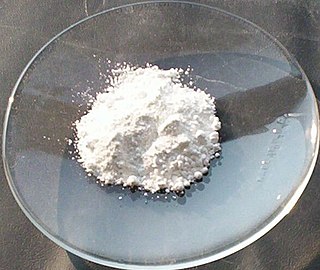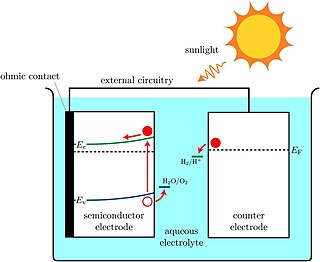
A pnictogen is any of the chemical elements in group 15 of the periodic table. Group 15 is also known as the nitrogen group or nitrogen family. Group 15 consists of the elements nitrogen (N), phosphorus (P), arsenic (As), antimony (Sb), bismuth (Bi), and moscovium (Mc).

Iron(III) oxide or ferric oxide is the inorganic compound with the formula Fe2O3. It is one of the three main oxides of iron, the other two being iron(II) oxide (FeO), which is rare; and iron(II,III) oxide (Fe3O4), which also occurs naturally as the mineral magnetite. As the mineral known as hematite, Fe2O3 is the main source of iron for the steel industry. Fe2O3 is readily attacked by acids. Iron(III) oxide is often called rust, since rust shares several properties and has a similar composition; however, in chemistry, rust is considered an ill-defined material, described as hydrous ferric oxide.

Zinc oxide is an inorganic compound with the formula ZnO. It is a white powder which is insoluble in water. ZnO is used as an additive in numerous materials and products including cosmetics, food supplements, rubbers, plastics, ceramics, glass, cement, lubricants, paints, sunscreens, ointments, adhesives, sealants, pigments, foods, batteries, ferrites, fire retardants, semi conductors, and first-aid tapes. Although it occurs naturally as the mineral zincite, most zinc oxide is produced synthetically.
A "photoelectrochemical cell" is one of two distinct classes of device. The first produces electrical energy similarly to a dye-sensitized photovoltaic cell, which meets the standard definition of a photovoltaic cell. The second is a photoelectrolytic cell, that is, a device which uses light incident on a photosensitizer, semiconductor, or aqueous metal immersed in an electrolytic solution to directly cause a chemical reaction, for example to produce hydrogen via the electrolysis of water.

Photoelectrolysis of water, also known as photoelectrochemical water splitting, occurs in a photoelectrochemical cell when light is used as the energy source for the electrolysis of water, producing dihydrogen which can be used as a fuel. This process is one route to a "hydrogen economy", in which hydrogen fuel is produced efficiently and inexpensively from natural sources without using fossil fuels. In contrast, steam reforming usually or always uses a fossil fuel to obtain hydrogen. Photoelectrolysis is sometimes known colloquially as the hydrogen holy grail for its potential to yield a viable alternative to petroleum as a source of energy; such an energy source would supposedly come without the sociopolitically undesirable effects of extracting and using petroleum.
Artificial photosynthesis is a chemical process that biomimics the natural process of photosynthesis. The term artificial photosynthesis is used loosely, refer to any scheme for capturing and storing energy from sunlight by producing a fuel, specifically a solar fuel. An advantage of artificial photosynthesis is that the solar energy can be immediately converted and stored. By contrast, using photovoltaic cells, sunlight is converted into electricity and then converted again into chemical energy for storage, with some necessary losses of energy associated with the second conversion. The byproducts of these reactions are environmentally friendly. Artificially photosynthesized fuel would be a carbon-neutral source of energy, which could be used for transportation or homes. The economics of artificial photosynthesis are not competitive.

Tungsten(VI) oxide, also known as tungsten trioxide is a chemical compound of oxygen and the transition metal tungsten, with formula WO3. The compound is also called tungstic anhydride, reflecting its relation to tungstic acid H2WO4. It is a light yellow crystalline solid.

Water splitting is the chemical reaction in which water is broken down into oxygen and hydrogen:

In chemistry, photocatalysis is the acceleration of a photoreaction in the presence of a photocatalyst, the excited state of which "repeatedly interacts with the reaction partners forming reaction intermediates and regenerates itself after each cycle of such interactions." In many cases, the catalyst is a solid that upon irradiation with UV- or visible light generates electron–hole pairs that generate free radicals. Photocatalysts belong to three main groups; heterogeneous, homogeneous, and plasmonic antenna-reactor catalysts. The use of each catalysts depends on the preferred application and required catalysis reaction.

Uranium dioxide or uranium(IV) oxide , also known as urania or uranous oxide, is an oxide of uranium, and is a black, radioactive, crystalline powder that naturally occurs in the mineral uraninite. It is used in nuclear fuel rods in nuclear reactors. A mixture of uranium and plutonium dioxides is used as MOX fuel. Prior to 1960, it was used as yellow and black color in ceramic glazes and glass.

Bismuth is a chemical element; it has symbol Bi and atomic number 83. It is a post-transition metal and one of the pnictogens, with chemical properties resembling its lighter group 15 siblings arsenic and antimony. Elemental bismuth occurs naturally, and its sulfide and oxide forms are important commercial ores. The free element is 86% as dense as lead. It is a brittle metal with a silvery-white color when freshly produced. Surface oxidation generally gives samples of the metal a somewhat rosy cast. Further oxidation under heat can give bismuth a vividly iridescent appearance due to thin-film interference. Bismuth is both the most diamagnetic element and one of the least thermally conductive metals known.
Photocatalytic water splitting is a process that uses photocatalysis for the dissociation of water (H2O) into hydrogen (H
2) and oxygen (O
2). The inputs are light energy (photons), water, and a catalyst(s). The process is inspired by Photosynthesis, which converts water and carbon dioxide into oxygen and carbohydrates. Water splitting using solar radiation has not been commercialized. Photocatalytic water splitting is done by dispersing photocatalyst particles in water or depositing them on a substrate, unlike Photoelectrochemical cell, which are assembled into a cell with a photoelectrode. Hydrogen fuel production using water and light (photocatalytic water splitting), instead of petroleum, is an important renewable energy strategy.

Bismuth oxychloride is an inorganic compound of bismuth with the formula BiOCl. It is a lustrous white solid used since antiquity, notably in ancient Egypt. Light wave interference from its plate-like structure gives a pearly iridescent light reflectivity similar to nacre. Previously, until the last decade of the twentieth century, bismuth oxochloride was known as bismuthyl chloride. It is also known as pigment pearl white.
A solar fuel is a synthetic chemical fuel produced from solar energy. Solar fuels can be produced through photochemical, photobiological, and electrochemical reactions.

Rose Amal is an Australian chemical engineer, currently serving as Scientia Professor and ARC Laureate Fellow in the School of Chemical Engineering at the University of New South Wales, Australia, where she is the director of the Particles and Catalysis Research Group. Previously she was Director of the ARC Centre of Excellence for Functional Nanomaterials (2010–2013). From 2012 to 2015 she was named in the Engineers Australia list of Australia's Top 100 Most Influential Engineers. In 2014 she became the first female engineer elected a Fellow of the Australian Academy of Science.
Light harvesting materials harvest solar energy that can then be converted into chemical energy through photochemical processes. Synthetic light harvesting materials are inspired by photosynthetic biological systems such as light harvesting complexes and pigments that are present in plants and some photosynthetic bacteria. The dynamic and efficient antenna complexes that are present in photosynthetic organisms has inspired the design of synthetic light harvesting materials that mimic light harvesting machinery in biological systems. Examples of synthetic light harvesting materials are dendrimers, porphyrin arrays and assemblies, organic gels, biosynthetic and synthetic peptides, organic-inorganic hybrid materials, and semiconductor materials. Synthetic and biosynthetic light harvesting materials have applications in photovoltaics, photocatalysis, and photopolymerization.

Kevin Sivula is a highly cited American chemical engineer and researcher in the field of solar cells. He is a professor of molecular engineering at EPFL and the head of the Laboratory for Molecular Engineering of Optoelectronic Nanomaterials at EPFL's School of Basic Sciences.
Kyoung-Shin Choi (Korean: 최경신) is a professor of chemistry at the University of Wisconsin-Madison. Choi's research focuses on the electrochemical synthesis of electrode materials, for use in electrochemical and photoelectrochemical devices.

Bismuth forms mainly trivalent and a few pentavalent compounds. Many of its chemical properties are similar to those of arsenic and antimony, although much less toxic.















